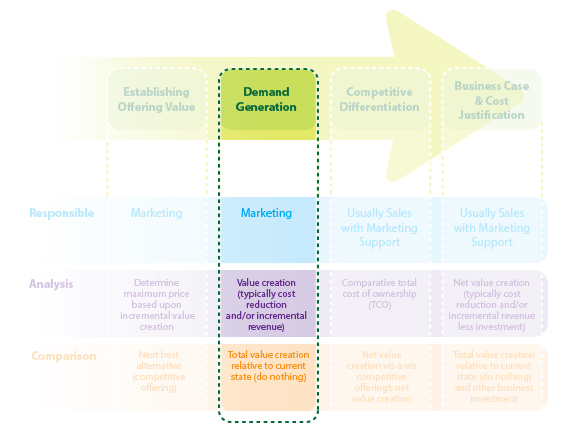
This is Part III of a five-part series about the value lifecycle in B2B selling and marketing. This post examines Phase 2 of the Value Lifecycle: Demand Generation.
Last week we talked about value as it relates to pricing. In Phase 2 of the Value Lifecycle, our understanding of value shifts slightly.
Your aim in Phase 2 is to establish the total cost of the prospect’s current business problem (or problems). That cost could be represented by money the customer is currently spending needlessly, and/or revenue the customer is currently missing out on. As we often explain to our clients, shining a flashlight on the size of a prospect’s problem sets you up to illustrate to the prospect how much value your solution can create for them.
Let’s look at a simple example. Say your prospective customer has a process in place for posting new job openings. This process is paper-based and requires three people to manage it. The labor cost to employ those three people is the size of the problem. Now let’s say your company has a solution that’s electronically based and only requires one person to manage the process. Not only would the customer save the labor cost of two employees, they’d also save on spending money to buy ink and paper. That’s the value created by your solution.
These kinds of cost savings scenarios can exist almost anywhere for customers. Your solution might reduce rent, labor costs, IT support costs, etc. Or your solution might, for example, impact revenue by increasing the number of sales leads or improving an online store’s uptime. No matter the specifics, the general question is, “How much is not implementing our offering/solution costing you?” and/or, “How much revenue are you losing because you lack our offering/solution?”
A key metric in Phase 2 is cost-to-delay per month. That’s the total value of the problem over the period of time (and, again, could be represented by potential revenue lost, unnecessary costs, or both). A month is usually a nice time frame, but you could also quantify the problem in weeks or years. Essentially, this calculation allows you to tell the customer, “Every month you don’t solve this problem, it’s costing you X amount.” Again, this is a way to create a sense of urgency around solving the problem.
Note that Phase 2 analysis doesn't take into account what your competitors are offering and how you compare to their solution. In the demand generation phase, you’re mostly concerned with what the customer is currently doing today. Why? The way you measure value changes based on where you are in the Value Lifecycle. In Phase 2, you’re not concerned with proving how you’re unique and different – that comes at a later stage. Your primary concern at this stage is to get the prospect excited about solving their current problem.
In Phase 3 you can start to explore the question, “Why should the customer buy from us,” (instead of either doing nothing or buying from your competitor). We’ll explore that concept in next week’s post.
What’s your biggest challenge in quantifying your prospect’s problems? Share your thoughts in the comments section.








